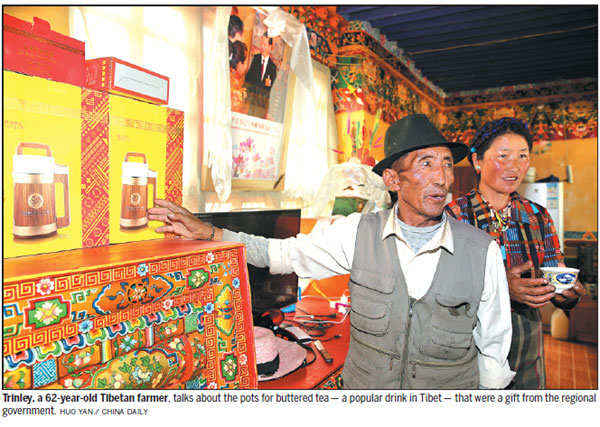Ema township in the Tibet autonomous region used to be synonymous with barren, windy land on the north bank of the Yarlung Zangbo River.
It is now an oasis, thanks to a forestation campaign launched by the government.
"Even grass was rare back then, let alone trees," said Ding Kun, head of the Ema township government, speaking of the time before the projects. He clearly remembers the bleakness and desolation.
Migmar, the 52-year-old village head of Liuguo, recalled the situation when he moved to a village in Ema in 2002.
"The sand brought by a storm overnight could block the door by morning. One time in 2004 we got lost while rushing back to our tent from the wilderness when a strong sandstorm hit the region. It was impossible to tell what direction we were going," Migmar said.
In 2013, the government of the Tibet autonomous region made the forestation project on the north bank of the Yarlung Zangbo River a regional ecological restoration strategy, following the central government's call to create an ecological civilization.
With the support of the Tibet government, and the government of Weifang, Shandong province, which central authorities assigned to help, inhabitants of Ema and local civil servants started the project.
The planned forest will cover 28,000 hectares and is expected to be finished in 17 years. An ecological demonstration area has been built with a combination of arbors, shrubs and grasses. Residents can also plant high-yield highland barley and organic potatoes.
A different way
Planting trees on the Qinghai-Tibet Plateau is different from planting them elsewhere. In late March, when many places enter a warm spring, the soil on the plateau remains partially frozen, and it's difficult even for heavy equipment to dig a hole.
Despite this, none of the procedures for planting trees can be omitted, especially the application of fertilizer. To ensure the trees' survival under the harsh conditions, tree planters must transport fertile soil from the other places to fill in the hole, together with large amounts of sheep manure, cow dung and other organic fertilizers. Watering must be done in a timely manner.
The most common plant in the Bazi ecological demonstration area is sea buckthorn. Like a banyan or aspen tree, many roots can sprout from a single sea buckthorn and gradually result in a small cluster of trees. The Bazi area covers more than 2,000 hectares and received a government investment of 150 million yuan ($22.3 million). There are also aspens, elms, willows and cathay poplars.
According to Lhapa Chosang, deputy head of the Namling county forestry bureau, the survival rate of the trees is 95 percent, thanks to rangers' care. He said planting is only the first step; looking after the trees is much more important on the plateau because of the harsh environment.
"Only when the trees survive will the people believe Namling can become an oasis," Chosang said.
"Water is a key factor. We built the irrigation water conservancy works first, chose the right trees and standardized the potholing, planting, watering and earthing-up procedures to ensure the survival rate," he said.
The Weifang city government invested 1.2 million yuan organizing a 30-person forest ranger team, most of whom are Tibetan shepherds. Under the direction of professional forestry technicians, they have become adept at irrigating, applying fertilizer, pruning, pest control, fence maintenance and fire prevention.
Grass, wildlife
The vegetation improves the soil, and all kinds of wild grass sprouts up under the trees. In autumn, the forest attracts wild doves, black-necked cranes, rabbits and foxes, which further contribute to the restoration of the ecology and help form a positive cycle in the ecological system.
After the development of the ecological demonstration area, the number of sandy days has been reduced by one-third, the oxygen content in the air in the area has increased 5 percent and the humidity has risen 10 percent, Namling forestry bureau data show.
Some local Tibetans did not think the trees could survive at first. Trinley, a 62-year-old farmer from Ema's Dechen village, is one of them.
"Even birds can't cross the sandy barren land during the windy winter and spring. We didn't believe trees could grow in the difficult environment," he said.
Trinley has eked out a living by planting barley, potatoes and carrots on small patches of land nourished by cow and sheep manure. He said locals had tried to plant trees for generations, but not a single tree has survived, entrenching the concept among them that trees cannot grow there.
When the government initiated the forest project, they even worried that the ecological demonstration area might eat up valuable farmland and pasture, Trinley said. "But later, we realized that the improved ecology benefits all of us."
'We see hope'
Trinley is now employed as a forest ranger, which markedly increased his income. "Seeing the trees grow, we see hope; and we become more active in taking part in planting trees and looking after the forests," he said.
Weifang helped to build a 60-hectare tree nursery in 2015. It develops saplings for the ecological demonstration area. Last year, the nursery produced 60,000 saplings worth more than 2 million yuan.
Ding Kun said the forest project and government forestry subsidy have increased incomes of many families, lifted people out of poverty and created jobs so that locals don't need work elsewhere.
Li Yang contributed to this story.
huoyan@chinadaily.com.cn

